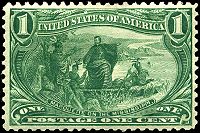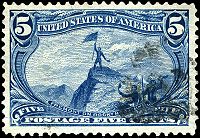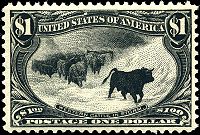
Trans-Mississippi Issue
Encyclopedia

The Trans-Mississippi Issue, or "Trans-Miss" for short, is a set of nine commemorative
Commemorative stamp
A commemorative stamp is a postage stamp, often issued on a significant date such as an anniversary, to honor or commemorate a place, event or person. The subject of the commemorative stamp is usually spelled out in print, unlike definitive stamps which normally depict the subject along with the...
postage stamp
Postage stamp
A postage stamp is a small piece of paper that is purchased and displayed on an item of mail as evidence of payment of postage. Typically, stamps are made from special paper, with a national designation and denomination on the face, and a gum adhesive on the reverse side...
s issued by the United States
United States
The United States of America is a federal constitutional republic comprising fifty states and a federal district...
to mark the 1898 Trans-Mississippi Exposition
Trans-Mississippi Exposition
The Trans-Mississippi and International Exposition was a world's fair held in Omaha, Nebraska from June 1 to November 1 of 1898. Its goal was to showcase the development of the entire West, stretching from the Mississippi River to the Pacific Coast. The Indian Congress was held concurrently...
held in Omaha, Nebraska
Omaha, Nebraska
Omaha is the largest city in the state of Nebraska, United States, and is the county seat of Douglas County. It is located in the Midwestern United States on the Missouri River, about 20 miles north of the mouth of the Platte River...
. The finely engraved stamps depict various scenes of the West and are today highly prized by collectors.
Edward Rosewater
Edward Rosewater
Edward Rosewater, born Edward Rosenwasser, was a Republican Party politician and newspaper editor in Omaha, Nebraska...
, then publisher of the Omaha Daily Bee and in charge of publicity for the Exposition, suggested the special stamps on December 13, 1897, and 10 days later Postmaster-General James A. Gary agreed, promising a series of five stamps ranging from one cent to one dollar. This announcement prompted protests from stamp collectors, who were still unhappy about the high price of the Columbian Issue
Columbian Issue
The Columbian Issue, often simply called the Columbians, is a set of 16 postage stamps issued by the United States to mark the 1893 World Columbian Exposition held in Chicago...
of 1893 ($16.34, a princely sum at the time), but Gary was unmoved, saying he decided on the issue "because I wanted to help the people of the West." Indeed, Gary subsequently made the set even more expensive by adding four more stamps to the series, including a $2 denomination.

Spanish-American War
The Spanish–American War was a conflict in 1898 between Spain and the United States, effectively the result of American intervention in the ongoing Cuban War of Independence...
broke out, and the Bureau of Engraving and Printing
Bureau of Engraving and Printing
The Bureau of Engraving and Printing is a government agency within the United States Department of the Treasury that designs and produces a variety of security products for the United States government, most notable of which is paper currency for the Federal Reserve. The Federal Reserve itself is...
—now required to produce large numbers of revenue stamp
Revenue stamp
A revenue stamp, tax stamp or fiscal stamp is a adhesive label used to collect taxes or fees on documents, tobacco, alcoholic drinks, drugs and medicines, playing cards, hunting licenses, firearm registration, and many other things...
s—chose to save time by printing the Trans-Mississippi designs in single colors. Even so, the stamps were late, not going on sale until June 17, over two weeks after the Exposition opened.
Philatelic protests notwithstanding, they were received favorably by the general public. They went off sale at the end of the year, and postmasters were directed to return unsold stock, which was then incinerated. (Although the numbers printed are known, the numbers returned were not recorded, and so the numbers of existing stamps are unknown.)

Wheat
Wheat is a cereal grain, originally from the Levant region of the Near East, but now cultivated worldwide. In 2007 world production of wheat was 607 million tons, making it the third most-produced cereal after maize and rice...
and corn
Maize
Maize known in many English-speaking countries as corn or mielie/mealie, is a grain domesticated by indigenous peoples in Mesoamerica in prehistoric times. The leafy stalk produces ears which contain seeds called kernels. Though technically a grain, maize kernels are used in cooking as a vegetable...
appear in odd corners of the frame. Each center design is inscribed with its title:
- 1¢ dark green - "MarquetteJacques MarquetteFather Jacques Marquette S.J. , sometimes known as Père Marquette, was a French Jesuit missionary who founded Michigan's first European settlement, Sault Ste. Marie, and later founded St. Ignace, Michigan...
on the MississippiMississippi RiverThe Mississippi River is the largest river system in North America. Flowing entirely in the United States, this river rises in western Minnesota and meanders slowly southwards for to the Mississippi River Delta at the Gulf of Mexico. With its many tributaries, the Mississippi's watershed drains...
" - 2¢ copper red - "Farming in the West"
- 4¢ orange - "IndianNative Americans in the United StatesNative Americans in the United States are the indigenous peoples in North America within the boundaries of the present-day continental United States, parts of Alaska, and the island state of Hawaii. They are composed of numerous, distinct tribes, states, and ethnic groups, many of which survive as...
Hunting BuffaloAmerican BisonThe American bison , also commonly known as the American buffalo, is a North American species of bison that once roamed the grasslands of North America in massive herds...
" - 5¢ dark blue - "FremontJohn C. FrémontJohn Charles Frémont , was an American military officer, explorer, and the first candidate of the anti-slavery Republican Party for the office of President of the United States. During the 1840s, that era's penny press accorded Frémont the sobriquet The Pathfinder...
on Rocky MountainsRocky MountainsThe Rocky Mountains are a major mountain range in western North America. The Rocky Mountains stretch more than from the northernmost part of British Columbia, in western Canada, to New Mexico, in the southwestern United States...
" - 8¢ violet brown - "Troops Guarding TrainWagon trainA wagon train is a group of wagons traveling together. In the American West, individuals traveling across the plains in covered wagons banded together for mutual assistance, as is reflected in numerous films and television programs about the region, such as Audie Murphy's Tumbleweed and Ward Bond...
"

- 10¢ slate - "Hardships of Emigration"
- 50¢ olive - "Western Mining ProspectorProspectingProspecting is the physical search for minerals, fossils, precious metals or mineral specimens, and is also known as fossicking.Prospecting is a small-scale form of mineral exploration which is an organised, large scale effort undertaken by mineral resource companies to find commercially viable ore...
" - $1 black - "Western CattleCattleCattle are the most common type of large domesticated ungulates. They are a prominent modern member of the subfamily Bovinae, are the most widespread species of the genus Bos, and are most commonly classified collectively as Bos primigenius...
in Storm" - $2 orange brown - "Mississippi River Bridge"
The designs were adapted from various photographs, drawings, and paintings; both the 8¢ and 50¢ values reproduced drawings by Frederic Remington
Frederic Remington
Frederic Sackrider Remington was an American painter, illustrator, sculptor, and writer who specialized in depictions of the Old American West, specifically concentrating on the last quarter of the 19th century American West and images of cowboys, American Indians, and the U. S...
. While all have been praised for their quality, the $1 value, commonly called the "Black Bull", stands out from the rest. Ironically, it does not reproduce an Western American scene, but was taken from a painting of cattle in the Scottish Highlands by John A. MacWhirter
John MacWhirter
John MacWhirter, was a Scottish landscape painter.-Biography:John was the third of four children. He attended a school in Colinton, and after his father's death was apprenticed to Oliver & Boyd, booksellers in Edinburgh...
(see also Western Cattle in Storm
Western Cattle in Storm
Western Cattle in Storm is a $1 stamp issued by the U.S. Postal Office as part of the 1898 Trans-Mississippi Issue. Western Cattle in Storm is one of nine commemorative postage stamps in the series, which marked the 1898 Trans-Mississippi Exposition held in Omaha, Nebraska...
).
In 1998, to mark the 100th anniversary of the issue, the United States Postal Service
United States Postal Service
The United States Postal Service is an independent agency of the United States government responsible for providing postal service in the United States...
issued a miniature sheet
Miniature sheet
A souvenir sheet or miniature sheet is a small group of postage stamps still attached to the sheet on which they were printed. They may be either regular issues that just happen to be printed in small groups , or special issues often commemorating some event, such as a national anniversary,...
of the nine, each printed in two colors, and a sheet of nine of the "Black Bull". In most of the images, the original color scheme was preserved, but for the "Black Bull" the hue of the frame was changed from violet-brown to bright red. The designs are reproductions; they have a small "1998" worked into the frame.
External links
- Philipps' Stamp Site showing images of all nine stamps of the original issue.
- 1847 USA showing images of all 1898 U. S. stamps, including the nine of the Trans-Mississippi issue.
- Image of the bi-color re-issue of 1998.

